

















Big Yields ONE GROWER PUBLISHING, LLC THE PEANUT PRODUCER'SMARKETING & PRODUCTION MAGAZINE www.peanutgrower.com PEANUT GROWER The JUNE 2023 Early Varieties O ff er The Endangered Species Act: How Does It Affect You? Look Out For LCB, Other Problem Pests For Oklahoma
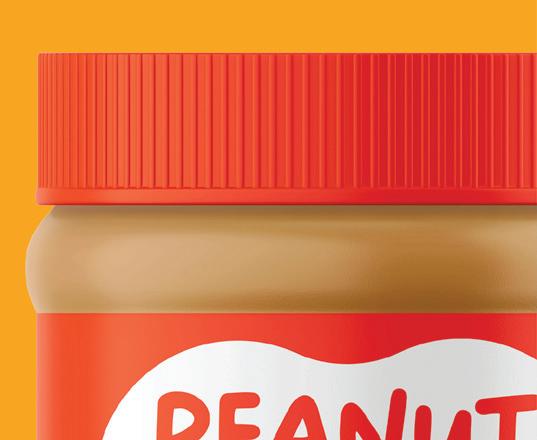



Creamy • Chunky • Comfy
peanut farmers grow comfort. you get PEANUT BUTTER.
Scouting










Way Forward















JUNE 2023 • THE PEANUT GROWER / 3 TWITTER: @PEANUTGROWER 10 4 Editor’s Note Repairing the safety net 5 News Briefs Commodity programs are only 4% of Farm Bill costs 8 Market Watch Farmers have tepid response to contract offers Volume 35 • Number 6 On the cover: Peanut digging on Keahey Farms, Beckham County, Oklahoma. Big Yields ONE GROWER THE PEANUT PRODUCER'SMARKETING & PRODUCTION MAGAZINE www.peanutgrower.com PEANUT GROWER The JUNE 2023 Early Varieties Offer The Endangered Species Act: How Does It Affect You? Look Out For LCB, Other Problem Pests For Oklahoma Big Yields Features
Peanut Industry Well Represented In Farm
Hearings
increase in the reference price and a voluntary base update are the primary requests.
the right varieties to fit their season
a
that has paid off for Oklahoma producers.
9
Bill
An
10 Meeting The Challenge Head-On Finding
is
task
12 The Endangered Species Act
LCB
How does this legislation affect you, and what can you do to help? 16 Look Out For
is the best way to discover this and other yield-robbing pest problems. 18 Guiding The
Peanut Pointers Make decisions on calcium, boron in the next few weeks JUNE 2023
Sign up for the monthly e-newsletter at peanutgrower.com to have exclusive industry news and content delivered directly to your inbox. www.peanutgrower.com PeanutGrower @PeanutGrower @ThePeanutGrower
Southeast Climate Hub’s commodity guides help in hurricane preparation and recovery. Departments 20
Stay Connected
EDITORIAL/PRODUCTION
Editor Amanda Huber ahuber@onegrower.com
Copy Editor Cassidy Nemec cnemec@onegrower.com
Art Director Ashley Kumpe
Digital Content Manager Katie Guthrie
ADMINISTRATION
Publisher/Vice President
Lia Guthrie (901) 497-3689 lguthrie@onegrower.com
Associate Publisher/Editor-In-Chief


Carroll Smith (901) 326-4443
Associate Publisher/Sales Scott Emerson (386) 462-1532 semerson@onegrower.com
Audience Services
Kate Thomas (847) 559-7514
Production Manager David Boyd dboyd@onegrower.com
For subscription changes or change of address, call (847) 559-7578 or email peanutgrower@omeda.com
EDITORIAL ADVISORY BOARD
Scott Monfort
Extension Agronomist
University of Georgia
Dell Cotton
Peanut Growers Cooperative
Marketing Assn., Franklin, VA
Kris Balkcom
Agri-Program Associate
Auburn University
Dan Anco
Extension Peanut Specialist
Clemson University
Editor’s Note
Repairing The Safety Net
It’s time again for another Farm Bill. Like birthdays, it seems to come around faster than it did some years ago.
Besides being another opportunity to get in front of our elected officials and remind them of the importance of agriculture to America’s well-being, it is also a chance to cover any gaps in farm programs. For the most part, the Price Loss Coverage program has been sound, but the U.S. Peanut Federation is asking for a couple of changes.
Emi Kimura
Extension Agronomist
Texas A&M University
David Jordan
Extension Agronomist
North Carolina State University
Glen Harris
Extension Agronomist
University of Georgia
Jason Ferrell
Extension Weed Specialist University of Florida
ONE GROWER PUBLISHING, LLC
Mike Lamensdorf PRESIDENT/TREASURER Lia Guthrie PUBLISHER/VICE PRESIDENT
The Peanut Grower (ISSN 1042-9379) is an agribusiness magazine for U.S. peanut producers. Published in eight monthly issues, January through July and November. Annual subscriptions are $40.00. Single Copy price is $5.00. Annual overseas subscriptions are $70.00, including Canada/Mexico. Periodicals postage paid at at Memphis, Tennessee, and at additional mailing o ices. Copyright © 2023 One Grower Publishing, LLC, all rights reserved except where otherwise noted. The Peanut Grower ® is a registered trademark, which reserves all rights granted by the U.S. Patent and Trademark O ice in association with the registration.
POSTMASTER: SEND ADDRESS CHANGES TO OMEDA COMMUNICATIONS, CUSTOMER SERVICE DEPARTMENT, P.O. BOX 1388, NORTHBROOK, IL 60065-1388. All statements, including product claims, are those of the person or organization making the statement or claim. The publisher does not adopt any such statement or claim as its own, and any such statement or claim does not necessarily reflect the opinion of the publisher. Printed in the USA.
One Grower Publishing, LLC, also publishes Cotton Farming, Rice Farming, Soybean South and Corn South
One Grower Publishing, LLC 875 W. Poplar Ave., Suite 23, Box 305 Collierville, TN 38017
At a Farm Bill Listening Session held in Newberry, Florida, Georgia Peanut Commission chairman Joe Boddiford said he is a fifth-generation farmer and is currently working on his 50th full-time crop. “Fortunately, I have a 28-year-old son who is following in my footsteps, and I want to do all that I can to make sure he is successful also. Good farm policy is essential for that to happen.”
Amanda Huber Editor, e Peanut Grower
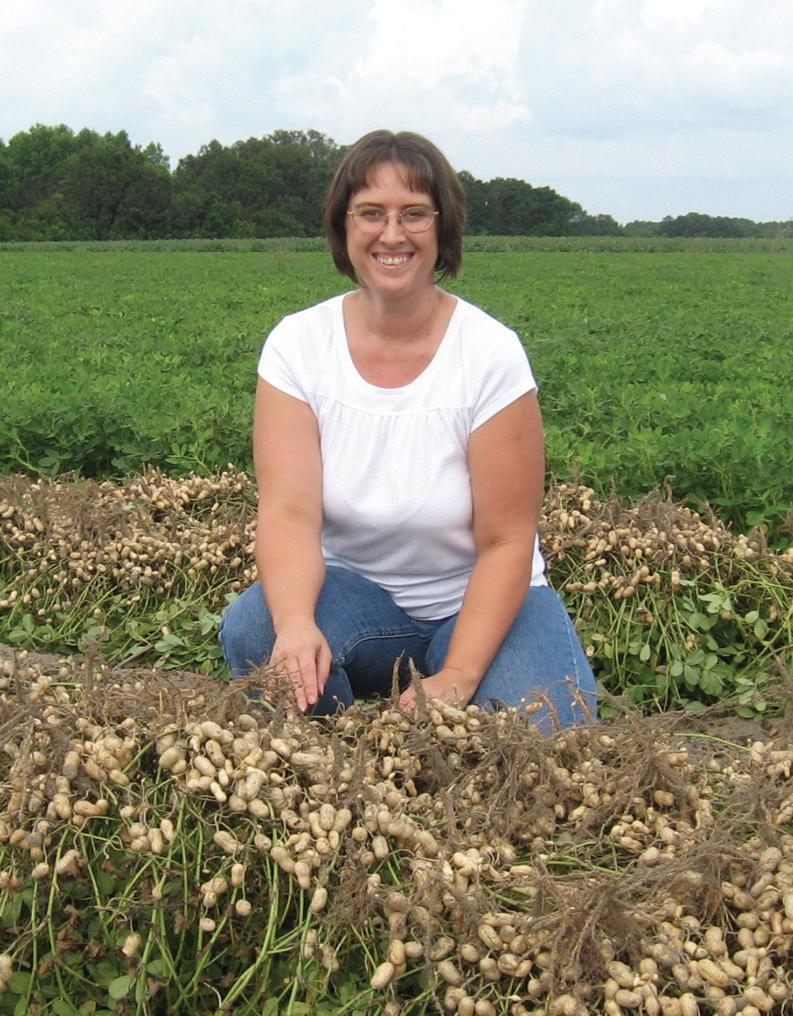
He went on to say that Georgia’s peanut growers support the current 2018 Farm Bill PLC program for peanuts.
“Unfortunately, input costs have skyrocketed,” he says. “We find ourselves with a reference price that is too low and that has caused the PLC program to not be an effective safety net. We ask the committee to increase the reference price in the 2023 Farm Bill.”
John Gray, who runs Williston Peanut and is also a peanut grower, spoke about the need for a voluntary base update on peanut acreage so that all producers could participate in the base. He also asked for an increase in the reference price to make the safety net viable again.
“Peanuts are one of the cheapest proteins in the grocery store, and when recession hits, that peanut butter is what feeds America. We need to make sure it keeps doing that.”
You can read about the U.S. House and Senate subcommittee hearings on page nine.
4 / THE PEANUT GROWER • JUNE 2023 PEANUTGROWER.COM
News Briefs
No Better Return On Investment Than The Farm Bill
The Farm Bill process kicked off in February with the release of the Congressional Budget Office baseline, which identifies the expected cost for farm programs over the next 10 years. It also outlines what is available to the U.S. Congress for program spending as they begin drafting the bill. The report projected $1.5 trillion in total costs, of which 82% is for nutrition and feeding programs, 4% for conservation, 4% for commodity programs and 7% for crop insurance.
In March, the U.S. House Agriculture Committee approved a letter regarding the fiscal year 2024 budget. After the letter was favorably reported out of the committee, Chairman Glenn “GT” Thompson (R-PA) issued the following statement:
“The committee’s budget views and estimates letter outlines a clear, bipartisan blueprint to invest in the hardworking men and women of American agriculture — the folks who work 365 days a year to feed and fuel our nation. While additional funds are necessary, there is no piece of legislation that provides a better return on investment than the Farm Bill.
“In the wake of record inflation, a global pandemic and geopolitical turmoil, American farmers, ranchers, foresters, producers and consumers are suffering. The best way to support them is to pass an effective, bipartisan and timely Farm Bill, and the letter considered today provides a sensible path forward.”
A Challenge To Check-Off Programs
The U.S. Peanut Federation signed a letter with other commodity organizations opposing S. 557 and H.R. 1249, titled “Opportunities for Fairness in Farming (OFF) Act.” This legislation was introduced by Sens. Cory Booker
(D-NJ) and Mike Lee (R-UT) and Reps. Dina Titus (D-NV) and Nancy Mace (R-SC) to target commodity research and promotion boards, known as “check-off” programs. This legislation would substantially undermine the research and promotion boards’ ability to promote U.S. agriculture.
Georgia Growers Invest In Research

The Georgia Peanut Commission board of directors has approved $706,139 in research funding for the 2023-24 budget year. The approved projects include 35 proposals submitted from the University of Georgia, Abraham Baldwin Agricultural College and the U.S. Department of Agriculture Agricultural Research Service.
Georgia’s peanut growers invest $2 per ton annually toward programs that include research, promotion and education. The research programs primarily focus on peanut breeding, conservation methods, irrigation and water management, as well as pest, weed and disease management.
“As a peanut grower, I’m proud to invest in the GPC and in the future of the peanut industry by supporting research that continues to demonstrate a return on our investment,” says Donald Chase, GPC research committee chairman. “We are proud of our partnership with research institutions and look forward to seeing results that will benefit farmers and enhance the sustainability of our crop.”
Additionally, GPC manages funding for the Southeastern Peanut Research Initiative that includes $1.3 million for projects in Alabama, Florida and Georgia. These projects are funded through the National Peanut Board check-off.
2023 International Peanut Forum
The 2023 International Peanut Forum was held in Lisbon, Portugal,
In Brief

• Commodity programs account for 4% of Farm Bill’s $1.5 trillion projected costs.
• Bipartisan congressional e ort targets commodity research and promotion boards.
• GPC approves 35 proposals and $700,000 plus for research.
• Alabama producers renew referendum with 91% vote.
• Peanut Innovation Lab renewed with $15 million grant.
• North Carolina Peanut Growers Association celebrates 70 years, unveils new logo.
April 26-28. The industry’s premier event brought together more than 325 attendees from 35 countries to discuss the latest issues and opportunities in the global peanut market. It is the only event where peanut industry leaders from around the globe gather to make connections and conduct business around vital peanut issues.
The IPF theme for 2023 was “Connecting the Peanut World.” This year’s conference covered key areas of the peanut supply chain, including research, market trends and new product development, sustainability and the use of peanuts to fight malnutrition.
The conference program included keynote speaker Veerle Poppe, sustainability strategist for Belgium’s leading retailer, the Colruyt Group. Other speakers included: Diego Bracco, Maniagro Argentina; Erwan Chapuis, Nutriset Group; Robson Fonseca, Coplana; Edoardo Fracanzani, Camara Argentina del Mani; Wessel Higgs, Triotrade Gauteng Pty Ltd.; Collins McNeill, MC McNeill & Co.; Irene Moreno, Importaco; Stu MacDonald,
JUNE 2023 • THE PEANUT GROWER / 5 TWITTER: @PEANUTGROWER
News Briefs
ManiLife; Richard Owen, American Peanut Council; Bob Parker, National Peanut Board; Tessa Schoones, Innova Market Insights; Dr. Samara Sterling, The Peanut Institute; Nilesh Vira, IOPEPC; Joaquin Zavala, Comasa; and Peng Zhang, Qingdao Peanut Import & Export Association.
Alabama Producers Approve Referendum
Alabama peanut farmers voted to continue the current assessment on peanuts that is collected by the Alabama Department of Agriculture and Industries and administered by the Alabama Peanut Producers Association. In a referendum conducted April 20, 2023, 91% voted “yes” to continue APPA’s programs in education, promotion and research.
The referendum is conducted every three years. However, a bill passed in the Alabama legislature changes the requirement to five years after 2026.
“The check-off we receive funds production research, grower and consumer education. It’s important that we con-
tinue to promote our nutrient-packed peanuts, peanut butter and other peanut products,” says Carl Sanders, APPA president and Coffee County peanut farmer. “The referendum results are indicative of the great work APPA does on behalf of our peanut farmers.”
In the past three years, more than $500,000 has been invested in production research in partnership with Auburn University and the Alabama Cooperative Extension System. This research has contributed to yield increases and more efficient production practices.
More than $600,000 has been utilized in promotion, contributing to an increase in peanut and peanut butter consumption. Another win is the early introdution of peanuts to infants recommendations by more Alabama pediatricians and parents. Peanut allergy education efforts are also included in the promotions.
In grower eduction, more than $400,000 has been allocated for grower production meetings, the APPA website, quarterly newsletters, social media and emails.


Substantial Grant For Peanut Innovation Lab
Farmers around the world grow peanuts because the plant adapts to poor soils and produces a crop even as drought becomes more common. Peanuts are shelf-stable, nutritious, don’t require expensive fertilizer and people like to eat them. Smallholder farmers around the world grow the crop on modest plots and cook the nuts into traditional dishes or sell the crop for money to send their kids to school.
In April, the U.S. Agency for International Development and the University of Georgia announced a five-year extension of their collaborative research and outreach work in peanut innovation.
The $15 million grant from USAID will allow the Feed the Future Innovation Lab for Peanut, which is headquartered in the UGA College of Agricultural and Environmental Sciences, to scale up the findings from previous research and get the technology into farmers’ fields.

“We are pleased that USAID has chosen to continue their funding of the Peanut Innovation Lab for another five years,” says CAES Dean and Director Nick T. Place.
APC Hires Seasoned Communicator For New Post
The American Peanut Council recently announced the hiring of Tracy Grondine as vice president of communications. Grondine brings a wealth of experience in developing communications, marketing, media and branding for mission-driven organizations.

Grondine fills a newly created role at APC to develop and execute a clear, consistent brand across all of APC’s programs and services, both in the United States and globally. Grondine will apply her expertise to increase industry awareness of APC and its activities on the industry’s behalf, grow membership and establish APC as an industry trend spotter and thought leader. Grondine will also work with The Peanut Foundation and the American Peanut Research and Education Society, which are under APC’s management.
tainable food systems both here and abroad. The important work done through this program is a critical part of that mission, and we are excited to see what results come out of the Peanut Innovation Lab during this next funding cycle.”
Many of the research findings apply throughout the world, including here in the United States, while the field work is performed in Senegal and Ghana in Western Africa, and Uganda and Malawi in Eastern and Southern Africa.
6 / THE PEANUT GROWER • JUNE 2023 PEANUTGROWER.COM
Tracy Grondine
News Briefs
New Trends And Peanuts
The National Peanut Board returned to the Culinary Institute of America at COPIA in Napa, California, to discuss the future of food during the annual Next Gen Food Summit. This event brings the industry together – professional chefs, recipe developers, food service directors, consumer package goods brands, as well as notable food media and content creators – to learn and adapt to the tastes of the next generation.
During the two-day event, current food trends, such as being more globally focused and socially aware, as well as being more adventurous with food, were offered as the hallmarks of this generation.
Also during the event, Flavor & The Menu Publisher and Editor-in-Chief, Cathy Nash-Holley presented the Top 10 Food Trends with concepts that incorporate peanuts, such as Thai mashups, afternoon snacking and Asian-inspired breakfasts.
NPB marketing and communications associate


Lindsay Stevens and consultant Valeri Lea of Sherman Moritz hosted a future of food panel featuring: Thomas Adams, NPB alternate board member; Kristina Cho, cookbook author, recipe developer and content creator; Pyet DeSpain, global private chef and winner of the TV show Next Level Chef; Jaclyn London, registered dieti-
“I’m pleased that we have brought someone with Tracy’s deep communications and marketing expertise into the peanut family,” said Richard Owen, APC president and CEO.
Grondine worked in communications at the U.S. Apple Association, the American Farm Bureau Federation and held communications roles at the National Corn Growers Association, the National Council of Farmer Cooperatives and the National Grange. She has a Master’s degree in Political Management from George Washington University and a Bachelor of Arts in Political Science from the University of Charleston, West Virginia.
Grondine can be reached at tgrondine@peanutsusa.com
Summer Conference Planned
The 24th annual Southern Peanut Growers Conference is scheduled for July 27-29, 2023, at Sandestin Golf and Beach Resort in Miramar
tian and podcast host; and Chelsea Lindbeck, director of product development for Better Body Foods. Chef Pyet DeSpain did a cooking demonstration using peanuts in various ways.
Peanut farmer Thomas Adams of Alabama provided inside knowledge on how peanuts are grown and harvested and Sherry Coleman Collins, MS, RDN, LD presented about access and affordability across the food system.
The event concluded with a fun and interactive Market Basket Challenge. Attendees were given limited ingredients and asked to create a dish that reflected the summit discussions and incorporated a variety of peanut formats.
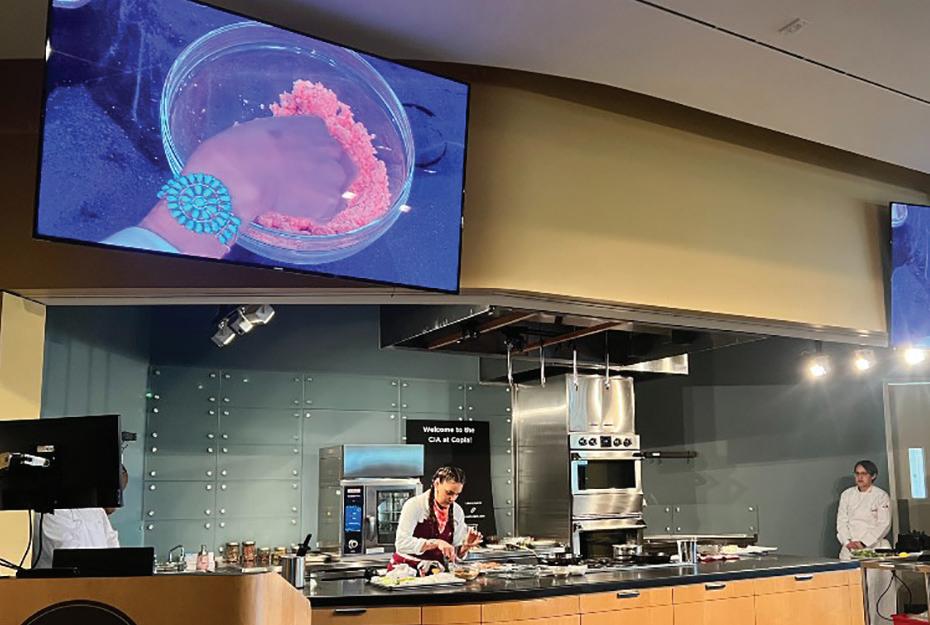
Beach, Florida. Hosted by the Georgia Peanut Commission and the grower associations in Florida, Alabama and Mississippi, the three-day event covers legislation, production, marketing and promotion.
The theme this year is “Building on our Strengths.” Room reservations at Sandestin Golf and Beach Resort can be made online at www.Sandestin. com/24o19r or by calling 800-3208115. For information, go to www. southernpeanutfarmers.org.
New Logo For North Carolina
The North Carolina Peanut Growers Association is celebrating 70 years of serving the state’s peanut producers in 2023, so there is no better time to unveil a new look. The consumer-focused logo represents three components of the peanut plant and also symbolizes three missions: advocacy, research and promotion. Additionally, the logo includes the words nutritious

and flavorful, two unique identifiers of the Virginia-type peanuts widely grown in North Carolina.
“It is an exciting time to be in the peanut industry,” says Ashley Collins, NCPGA chief executive officer. “Our growers produce more than just a commodity; peanuts are an affordable, plant-based protein source and a versatile ingredient in the food industry. Our 70th anniversary is an excellent opportunity to launch a new identity that is more relevant to today’s consumer audience and will generate demand for North Carolina-grown peanuts.”
North Carolina’s approximately 650 growers ended the 2022 season with an average yield of 4,260 pounds per acre.
JUNE 2023 • THE PEANUT GROWER / 7 TWITTER: @PEANUTGROWER
Market Watch

Tepid Response To Contract Offers
Cooler-than-normal temperatures at peanut planting time have also cooled off the peanut market.
At the farmer and buying point level, discussions have centered around the acreage estimate, cost of production, prices of competing crops, cost of producing competing crops and prices of corn, cotton and soybeans.
After the U.S. Department of Agriculture estimate of a 7% increase in peanut acreage, most agreed it would not be enough to flood the market. However, with an abundant harvest, there was also little hope of getting rid of the 1-million-ton carryforward.
Cost Of Production Increases

Costs of all inputs have farmers worried and that brings on other problems. Stanley Fletcher, policy professor at the Abraham Baldwin Agricultural College’s Rural Prosperity and Innovation Center, compared the representative peanut farms’ 2021 costs of production as compared to 2022 costs and found that the total costs increased 26.31%.
In prior representative farm updates, the peanut reference price of $535 per ton provided an effective safety net for growers. Total variable input costs such as seed, fertilizer, fuel and crop insurance have increased 33.48% when comparing 2021 to 2022. Fletcher says 2021 cost of production was $545.97 per ton, and in 2022, it was approximately $668 per ton.

Contracts, Finally
Eventually this spring, some shellers started offering $525 per ton for runner-type peanuts and $550 per ton on Virginia type. Some shellers are offering a sheller pool with a $500 per-ton floor hoping prices will increase later this season.
Response has been weak and varied with some buying points booking contracts and others reporting that farmers are in no hurry. They are keeping an eye on cotton and on industry problems
such as drought in West Texas and in foreign markets, like Argentina.
Buyers continue to point to December cotton at 80 cents per pound as a reason peanuts should see planting increases and falling prices for raw-shelled kernels. The option is $535 per-ton peanuts versus 80 cents per-pound cotton.
Current crop market is still very firm with prices in the Southeast in the low 60 cents per pound for kernels. Prices seem to have been buoyed by strong demand at home and an increase in European Union interest with the crop in South America very much in question. New crop is still trading very thinly in the mid 50 cents per pound.
Domestic And Export Markets
Raw peanuts in primary products are down 1.3%. Peanut butter continues to show a growing, strong market, up 4.7% for the eight-month marketing year. In-shells are on a roll, up 9.5% during that period. For the past seven months, U.S. peanut exports are down 2.82%. Mexico is still the top buyer, down only 2.55%, while Canada keeps buying more, up 5.27%. China is the third-largest buyer, still down 17.3%. Japan jumped up to the No. 4 buyer and the Netherlands is fifth in line.
Farm Bill Hearings
The Price Loss Coverage program
J. Tyron Spearman Contributing Editor, e Peanut Grower
will not have a payout in October as the average price paid to farmers will average above the $535 per ton reference price. While the PLC program has worked for peanut producers, input costs have risen substantially. Thus, the U.S. Peanut Federation supports an increase in the reference price.
Secondly, the federation supports a voluntary base update that includes growers with and without peanut base acres. The 2014 base update excluded many young farmers and new production areas.
When Alabama Sen. Tom Tuberville asked in his opening statement at the U.S. Senate Committee on Agriculture, Nutrition and Forestry hearing, why more than 558.9 million pounds of peanuts are produced annually in his home state for contracts less than $600 per ton when the costs of production are higher than that, producer Karla Thompson had an answer.
She said banks require a contract before granting an operating loan, and farmers hope that high yields will offset low prices or that membership in a grower-owned shelling facility will help capture a profit on the shelling and sale of peanuts, recouping losses on a low contract price.
Awesome answer. Read about the recent Farm Bill hearings on the page opposite.
8 / THE PEANUT GROWER • JUNE 2023 PEANUTGROWER.COM
Leading Marketing Indicators (May 1, 2023) 2023 Est. Acreage (+7%) ................................................. 1,547,000 acres 2022 Est. Production (- 12.5%) .......................................... 2,784,000 tons 2022-23 Market Loan ......................................................... 2,294,257 tons 2022-23 Remaining In Loan .............................................. 1,060,073 tons Domestic Usage (8 Mo.) ................................................................ – 1.3 % Exports (7 Mo) ................................................................................ – 2.82% NATIONAL POSTED PRICE (per ton) Runners - $424.68; Spanish - $413.41; Valencia and Virginias - $428.31
Peanut Industry Well Represented In Farm Bill Hearings
The U.S. House Agriculture Subcommittee on General Farm Commodities, Risk Management and Credit held a hearing on Tuesday, April 26, entitled “Producer Perspectives on the 2023 Farm Bill.” Representing the U.S. Peanut Federation was Daniel McMillan of Southern Grace Farms in Enigma, Georgia.
In McMillan’s testimony, he presented peanut priorities for the 2023 Farm Bill, namely an increase in the reference price for the Price Loss Coverage program. He outlined the financial stressors that peanut growers are facing on the farm.

“In my home area, we saw fertilizer costs double from 2021 to 2022. Some products tripled in price. Currently, fertilizer prices are changing week to week preventing us from making informed management decisions.”
Effects Of Inflation And Higher Costs
McMillan also voiced the support of the U.S. Peanut Federation for a voluntary base update that includes growers with and without peanut base acres. While the 2014 Farm Bill allowed for base updating for peanut growers that already had base on their farms, it excluded many young farmers and new production areas.
Subcommittee Chairman Austin Scott (R-GA) opened the hearing, saying, “Title I programs, specifically the Agricultural Risk Coverage and Price Loss Coverage, or ARC and PLC, were established in the 2014 Farm Bill and the reference prices used to determine assistance were set using 2012 cost of production data. Meanwhile, inflation has gone up significantly since 2012, and the price of most inputs have doubled or even tripled since 2021 alone. Farm sector debt is at record-high levels, and net farm income is expected to fall 16% from 2022 to 2023. These warning signs underscore the importance of our work in the 2023 Farm Bill.
Senate Hearing
The U.S. Senate Agriculture Subcommittee on Commodities, Risk Management and Trade held a hearing on Tuesday, May 2, 2023, entitled “Commodity Programs, Credit and Crop Insurance – Part 1: Producer Perspectives on the Farm Safety Net.” Representing the U.S. Peanut Federation was Karla Thompson of JET Farms and Integrity Farms in Camilla, Georgia.
Thompson’s testimony also emphasized including an increase in the reference price for the PLC program. Inflation on key farm inputs, including fuel, fertilizer and labor, have all contributed to the rising cost of production.
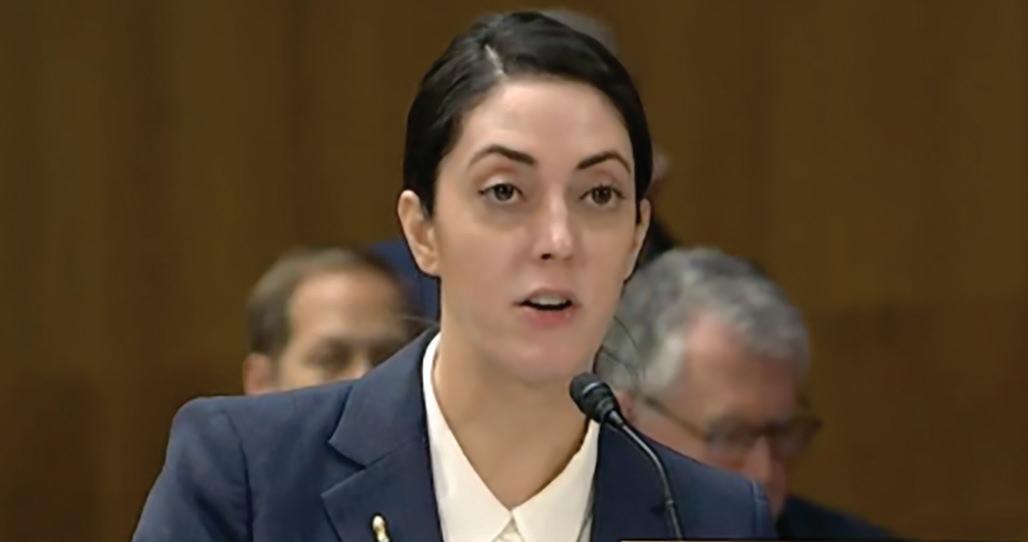
Thompson said, “On our farm alone, many of our expenses have almost doubled since 2018. Our fertilizer costs absolutely skyrocketed. We need certain fertilizers to sustain the right nutrient levels in the soil, both for the peanuts we are growing
in any given season and to protect the land for the future. In the past few years, we have experienced seasons where we could barely obtain the necessary products due to supply chain issues. Supply shortages directly translated to price increases, and our fertilizer expenses have as much as doubled.”
Labor Costs Add To The Woes
She also talked about the challenges of labor costs.
“Since 2018, it has become increasingly difficult to plan for and cover our labor costs. For example, we need skilled equipment operators to plant and harvest our peanuts safely and efficiently. Every year, it gets harder and harder to find local workers with those skills, and so we have come to rely on guest workers from Mexico that we recruit through the H2A visa program. The costs for the H2A program have always been high, but they have risen dramatically just this past year. In Georgia, the U.S. Department of Labor unexpectedly raised the H2A minimum wage by 14%, from $11.99 in December 2022 to $13.67 for 2023.”
Thompson also voiced the support of the U.S. Peanut Federation for a voluntary base update that includes growers with and without peanut base acres.
During the hearing, Thompson answered questions from U.S. Senators Raphael Warnock, (D-GA) and Tommy Tuberville, (R-AL) on the challenges that peanut producers are currently facing to grow such an important nutritional crop for all of America and for children, especially. PG
JUNE 2023 • THE PEANUT GROWER / 9 TWITTER: @PEANUTGROWER
Karla Thompson
Daniel McMillan
Meeting The Challenge Head-On
By Amanda Huber
Rogers and Hammerstein didn’t mention peanuts in their song “Oklahoma!” from the beloved musical and movie of the same name, later to become the official state song. They wrote about barley, carrots and “pertaters,” then “Pasture fer the cattle, spinach and termayters!” But farmers in the Sooner State didn’t let that stop them. Peanuts have been a staple there since the 1930s.
But when the average yield in other states climbed higher with improved varieties, in Oklahoma it languished. Two challenges have hindered the Oklahoma peanut industry: a lack of early contracts and a lack of varieties that fit the timing of their season. The first problem remains a challenge because it is a function of supply and demand. With help from buyers and research partners, Oklahoma producers took the second problem head-on. The result is that average yields have risen dramatically because of new varieties.
Contracts Too Late To Support Peanut Acres

Les Crall, who farms peanuts, grain sorghum, wheat, hay and cattle in Custer, Washita and Kiowa Counties and is past chairman of the National Peanut Board, says the growers who remain in Oklahoma are committed and do a really good job, but to get more acres, “we need contracts,” he says.

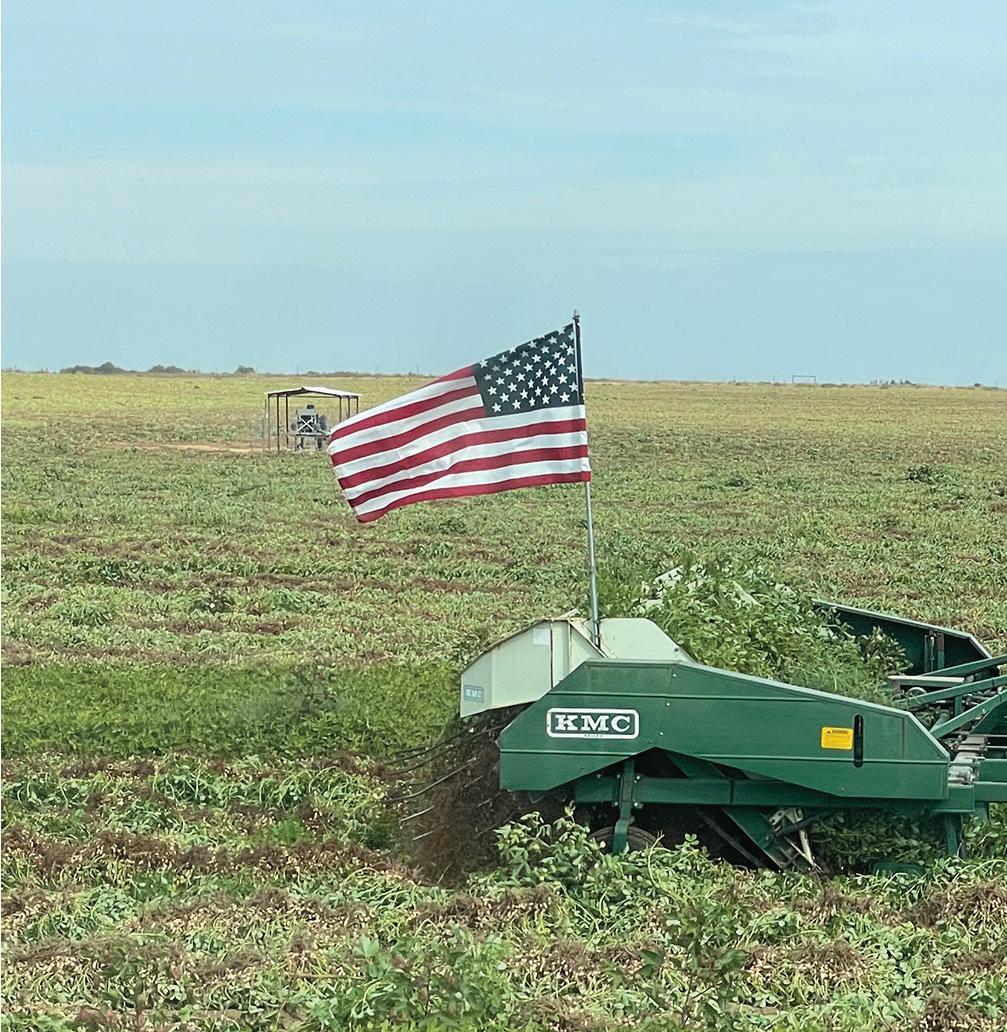
“New and improved varieties and continued research from our scientists are giving us the support we need. Everyone in the industry has to work together. But we are very dependent on contracts.”



David Nowlin, the fourth executive director of the Oklahoma Peanut Commission, started his position on April 1, 2023, with the retirement of Ron Sholar. Nowlin says when contracts come out late, as they did this year, growers must make the decision to move on.
“That’s not really anybody’s fault,” Nowlin says. “The shellers

10 / THE PEANUT GROWER • JUNE 2023 PEANUTGROWER.COM
Finding the right varieties to fit their season is a task that has paid off for Oklahoma producers.
had a tough time figuring out what their needs were going to be with extra acres in other states and trying to determine South America’s yields.
“The Spanish contract came out a little early, so that’s the bulk of our acreage. We will probably end up with around 9,500 acres of Spanish and only a couple thousand acres of runners because of the lateness of those contracts. We may have a few more acres of Virginias this year.”
Completing all four peanut types grown in the state, Nowlin says Valencias are grown on the western border of Oklahoma in Beckham County for Hampton Farms.
“We’re probably in the range of 14,000 acres,” he says. “We would love to go back to 17,000 acres or more.”
Varieties Early Enough To Mature Before A Frost
James Cleveland is a farmer-stock manager for Birdsong Peanuts with buying points in Wellington and Memphis, Texas, just across the state line. With a history of peanut buying in Oklahoma dating back to the 1990s, Cleveland was hired the same year as Jeff Carlisle, Birdsong Peanuts’ procurement manager. Cleveland says about seven years ago, Birdsong made a big push in Oklahoma to help producers find varieties that suited their needs.
“Jeff made it a priority that we find a better variety that is more suitable for Oklahoma. That’s when we started working with Dr. Kim Moore and Mark Carden of AgResearch, Inc. Variety pre-selections were made over the winter and then planted in the spring. In the summer, they came out and did evaluations.”
Cleveland says it wasn’t just ACI varieties that they looked at, but it was those varieties that rose to the top.
“It’s been a struggle to find high-oleic peanuts that were short season enough that they would work in Oklahoma without running into the risk of freeze damage,” he says. “There’s a saying here that you pick around in September trying to determine when to start, you harvest in October and you salvage peanuts in November. And there’s a lot of truth to that.
“The primary consideration for varieties is ‘Will that peanut grade 78 on Oct. 15?’ That means the peanuts are finished by that date and ready to pick. That’s been the ACI varieties for us. They have varieties that fit the bill and have been a big part of the increased production.”
New Record Yields And Good Grades
During the 1990s, Oklahoma peanut yields averaged 2,280 pounds per acre. In the succeeding decade (2001-2010), yields improved to almost 3,000 pounds per acre. The 2020 crop, at an average of 4,119 pounds per acre, was a state record but was quickly surpassed in 2021 with an average yield of 4,356 pounds per acre.
Kim Moore, ACI’s president and research director, says “Our main objectives have been to develop early maturing, high oleic runner, Spanish and Virginia market types with regional adaptation.
“We continue to work on early maturity because early frost is always a possibility in West Texas and Oklahoma,” Moore says. “Also, with the ability for growers to dig even two weeks early can potentially reduce water usage, input costs and the general risk of inclement weather.”
Nowlin says, “The big difference is varieties. That’s the big
change.”
Lariat, a variety released by U.S. Department of Agriculture’s Agricultural Research Service peanut breeder, Kelly Chamberlin is also gaining ground.
“Lariat seemed to hold up to the heat well last year and probably opened some eyes,” Nowlin says. “It has yielded well the past two years, and I expect we’ll see a seed increase in Lariat and have more available for 2024.”
Research On All Production Areas Continues
Cleveland says although varieties now are yielding and grading much better than even a few years ago, they continue to try new ones each season.

“We are trying four new cultivars this year, including a nematode-resistant variety. We have good producers who are progressive in their efforts,” he says.
Chamberlin agrees that improved genetics have contributed to the increased yields over time, but other factors such as crop rotation and precision farming methods have also played a major role in yield boosts. “All of these factors work in concert to improve sustainable farming and make the crop more profitable for the producer.”
Chamberlin’s program has focused on releasing cultivars, such as the runner cultivar ‘Lariat,’ that is resistant to fungal diseases, especially Sclerotinia blight.
“‘Lariat’ requires no fungicidal sprays during the growing season to control Sclerotinia blight. It is hard to convince the producer not to spray for control, but our studies have shown that doing so does not result in a yield boost for this cultivar.
“We are constantly trying to improve on the cultivars previously released,” she says. “We have Virginia and runner-breeding lines that have enhanced disease-resistance packages compared to currently grown cultivars that we are considering for release.
“All cultivars released from our breeding program have a high oleic acid content, which improves the shelf life on peanut products and has also been associated with health benefits, both which benefit the consumer,” Chamberlin says.
“Yields have been coming up, and we have a lot of good, experienced growers that have been farming a long time,” Nowlin says. “That makes a difference as well. We’re seeing more and more 5,500 pounds-per-acre yields, and that’s huge for us,”
One thing is certain: in Oklahoma, “where the wind comes sweepin’ down the plain,” farmers are ready to meet whatever challenges come their way. PG
JUNE 2023 • THE PEANUT GROWER / 11 TWITTER: @PEANUTGROWER
The Endangered Species Act
How does this legislation affect you, and what can you do to help?
By Cassidy Nemec, Contributing Editor
Figuring out how the Endangered Species Act affects the agricultural industry can be both complex and frustrating. The ESA of 1973 was enacted by Congress under President Nixon and has since drawn much attention to species across the United States that have the potential to be threatened or completely wiped from the map.

In recent years especially, it has become increasingly critical for growers, crop advisors, Extension and others throughout the agricultural industry to not just be aware of the ramifications from the ESA on their operations, but also to be more involved.

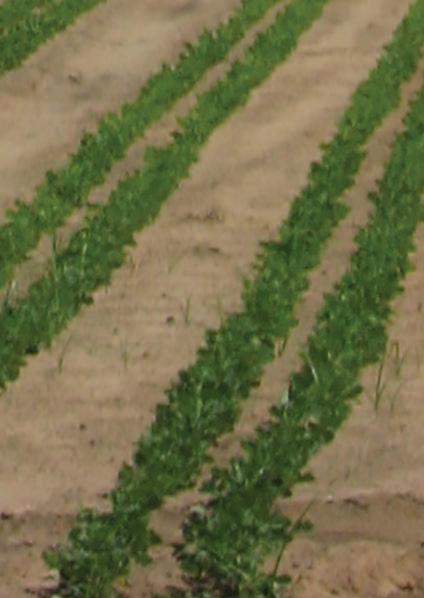

Who Has Jurisdiction?
In the sea of alphabet soup that is federal agencies, it is the U.S. Fish and Wildlife Services federal agency (or the National Marine Fisheries Service in cases of aquatic species) whom has jurisdiction over the ESA. According to the FWS website, the act itself “establishes protections for fish, wildlife and plants that are listed as threatened or endangered species, and for preparing and implementing plans for their recovery.”
Breaking Down The “Legalese”
■ FWS/NMFS has jurisdiction over ESA.
■ EPA has authority over FIFRA.
■ ESA focuses on continued existence of listed species and prohibits “taking” of them.

■ FIFRA deals with sale, distribution and use of pesticides.



■ Ideally, FWS and EPA work together to comply with ESA.

■ Both FWS and EPA are backlogged in casework and have been for a long time.
■ EPA released an updated workplan in 2022.
Read and follow all labeled pesticide directions and wear appropriate PPE. Print any related bulletins from EPA’s Bulletins Live! Two website as listed on the pesticide label and keep it with your pesticide paperwork.
PEANUTGROWER.COM
Species become listed one of two ways. The FWS may propose species or any citizen can petition for it. The citizen petition route is the most common way for this to happen, due in part to the FWS having an extreme backlog of requests it must funnel through, keeping the agency busy.
The FWS is involved in the candidate conservation, listing and classification and recovery processes as it relates to ESA. Their website also mentions the provision “for interagency cooperation to avoid take of listed species and for issuing permits for otherwise prohibited activities.” This brings up two concepts: interagency cooperation should be taking place and “take” can be broadly defined.
The Devil’s In The Definitions
Ag Law in the Field is a podcast hosted by Texas A&M AgriLife Extension ag law specialist Tiffany Lashmet. She recently sat down with Jonathan Wood, vice president of law and policy at the Property Environment Research Center. He has been working with ESA for years and discussed how “take” is defined in relation to the act.
“Essentially, it’s any private activity that harms a listed species and, to some extent, also its habitat. The FWS may also issue regulations extending that prohibition to threatened species,” Wood says. This applies for both endangered (listed) and threatened species in terms of critical habitat and conservation, but the ESA only applies the “take” definition to endangered species for private land use.
Reemphasizing what he terms the “teeth of the law,” Wood further explains what the “take” definition can encompass.
“Most people think it means you’re intentionally taking or harming, but the FWS interprets it far more broadly. If you harm a species, even unintentionally, if you disturb a species, if you modify its habitat in a way that may, in the future, restrict its ability to find food or to breed and reproduce — all of those things could violate the ‘take’ prohibition, which, depending on the species and the use of the land, can make continued use of that property really complicated.”
Wood says that FWS can also regulate all other agencies and their respective activities that could have any effect on species.
In the podcast, Wood says FWS is currently facing a 10-year backlog of citizen requests, including those requests made mainly by three major environmental litigation groups.
FIFRA And ESA
In 1947, the Federal Insecticide, Fungicide and Rodenticide Act was enacted with the original intent of establishing measures regarding the registering of pesticides used in interstate
What To Do:
■ Read and follow all labeled pesticide directions and wear appropriate PPE.
■ Go to the EPA’s Bulletins Live! Two website as listed on the pesticide label and search for the pesticide use limitations bulletin for the applicable area. Print out the bulletin and keep it with your pesticide paperwork. If PULAs are listed, follow these for the intended area, product and application month. If no PULAs are listed, it is important to still print the documentation saying there are no bulletins for that area in order to cover the applicator.
■ Continue or implement practices that help protect endangered
The UGA’s Eric Prostko says producers need to continue practices that support the Endangered Species Act, such as cover crops, and comment to the EPA on pesticide registrations and reregistrations when available. “We are trying to make sure that EPA will include mitigation measures that are science based and practical. They are willing to listen.”
commerce with the U.S. Department of Agriculture as well as labeling provisions. The act was later expanded due to concerns over pesticides’ toxic effects and residues. It now involves everything dealing with the “sale, distribution and use of pesticides,” according to U.S. Environmental Protection Agency’s website.
So where does FIFRA intersect with the ESA?
Wood says the ESA, while historically focused on more charismatic species like wolves in the Western United States, has gone nationwide in the last 20 years with more types of species being added to the list that are more vulnerable to pesticide use.

“Increasingly, the ESA is requiring EPA, when it’s approving pesticides, to set species-protective limits on how they’re used,” he says. “With every additional species you add to that process, with every different pesticide or application you’re adding, you just add to the complexity.”
Mitigation Strategies Affecting Ag Practices
Registering and reregistering pesticides takes time, and EPA has a similar backlog to FWS in their listing petitions and permitting process. They are supposed to be evaluating every product and how it may impact species, which is both challenging due to lack of data and time consuming with their ongoing list of what they should be accomplishing. In working to comply with ESA and FIFRA’s regulations, EPA has implemented the Endangered Species Protection Program to help with this large task at hand.
species and habitat, including cover crops, twin rows, strip-tillage and using irrigation to activate herbicides prior to rainfall.
■ Be diligent about keeping all pesticides on-target by paying attention to nozzle type, pressure, application speed and boom height, as well as maintaining situational awareness: Are sensitive crops nearby? What direction is the wind blowing? How fast is the wind blowing?
■ COMMENT, COMMENT, COMMENT! Stay aware of public notice and comment periods. Submit personal comments about product use on your farm to the EPA at every opportunity.
JUNE 2023 • THE PEANUT GROWER / 13 TWITTER: @PEANUTGROWER
STANLEY CULPEPPER, UGA EXTENSION
Counties with threatened/ endangered species highlighted in red.
Over 1,200 active ingredients, over 18,000 pesticide products
Thomas Butts, University of Arkansas Division of Agriculture Extension weed specialist, tells how ESA is currently impacting agriculture and what it might look like down the road for a process that is different for every product, state and active ingredient. “Moving forward, it’s going to be that we either have more regulations and paperwork to do in order to make legal applications — or we’re just going to outright lose options.”
University of Georgia Extension weed specialist Eric Prostko says herbicides such as atrazine and glyphosate are up next for registration. “The loss of these herbicides or increased restrictions on them would be a big problem,” he says.

Butts says the regulation process used to look more like a risk-benefit analysis but now is strictly a risk assessment with no benefits factored in. He also says there is a lack of any warning in the case of pulled products, such as when Arkansas lost the ability to use Enlist in 11 counties last year. “What was scary is that none of us knew that was coming. It was just kind of a memo slid across a desk one afternoon, and all of a sudden, we didn’t have those products in those counties anymore.”
He says they currently do not have any sort of consistency with the regulations nor the capability to know how to better prepare — or prepare at all — for when they do come along. Butts says better direction moving forward would help at least in the sense that they could figure out what to do to get a better handle on circumstances before they occur and to plan for the future.
Prostko says peanut growers are already doing several things to help protect endangered species and habitat. This includes cover crops, twin rows, strip-tillage and utilizing irrigation to activate herbicides prior to rainfall. “We are trying to make sure that EPA will include mitigation measures that are science based and practical. They are willing to listen.”
Comments Make A Difference
The EPA encourages those in agriculture to make comments during pesticide registration and reregistration processes.
Both Butts and Prostko say it is critical for producers to pay attention to when the comment periods are open and to submit comments.
Within the past two years, EPA has been having regular ESA-FIFRA meetings to work toward moving forward. They produced their first workplan in early 2022 and an update later that year. The update includes regulation review efforts and other initiatives, which include many mitigation strategies for both agricultural and nonagricultural use.
Within the endangered species component, EPA is attempting a biological evaluation on whether a particular product “may affect” a species. If so, they must look further into that product and consult FWS.
EPA is implementing early mitigation measures to protect species while the FWS works on their biological opinions. These measures address water runoff, soil erosion and drift and are incorporated into a picklist.
The Importance Of Bulletins Live! Two
Information related to geographic pesticide use limitations is included in Endangered Species Protection bulletins, which can be obtained through EPA’s website. As stated there, “Bulletins set forth geographically specific pesticide use limitations for the protection of threatened and endangered (listed) species and their designated critical habitat.”
UGA Extension weed specialist Eric Prostko says to be diligent about keeping all pesticides on-target by paying attention to nozzle type, pressure, application speed and boom height, as well as maintaining situational awareness: Are sensitive crops nearby? What direction is the wind blowing? How fast is the wind blowing?
“That’s an opportunity where EPA can hear directly from growers about our practices,” Butts says. “Getting those opinions and voices out there and having EPA hear them directly from growers and consultants goes a lot further than the mass emails or comments they get that are just a template or form signed by a different name.”
Prostko says it is important to remain diligent in everyday agricultural practices. “Growers should continue to read and follow all labeled pesticide directions and wear appropriate personal protective equipment. Growers must also stay diligent about keeping all pesticides (herbicides, fungicides, insecticides and fumigants) on-target by paying close attention to nozzle type, pressure, application speed and boom height, as well as maintaining situational awareness: Are sensitive crops nearby? What direction is the wind blowing? How fast is the wind blowing?”
He says ESA is not temporary. “Don’t fall asleep on this issue. ESA is not going away and is here to stay!” PG
Bulletins Live! Two is the application system that has been in place for a couple years and is where these bulletins are housed. This is where a pesticide label comes into play. When reviewing a label that directs you to the website, it will then instruct you on the pesticide use limitations for the applicable area, or PULAs. The applicator is required to follow these for the intended area, product and application month.
Bulletins are good for six months from the time they are created and protect the pesticide applicator for that entire length of time, even if additional measures arise that did not exist at the time of printing that bulletin. If no PULAs are listed, it is still important to print the documentation and keep it in your records saying there are no bulletins for that area in order to cover the applicator.
Information on how to find the EPA registration number needed to search for a product in the Bulletins Live! Two application, along with a tutorial on the system as a whole, is available at https://www.epa.gov/endangered-species/endangered-species-protection-bulletins. PG
For more information on EPA, FWS or any of the discussed Acts or programs, visit www.fws.gov or www.epa.gov.
14 / THE PEANUT GROWER • JUNE 2023 PEANUTGROWER.COM
ESA On The Farm Level
FOCUS




As challenges for producers mount this season, our team is working tirelessly to provide the latest in pro table production strategies to help boost your bottom line.




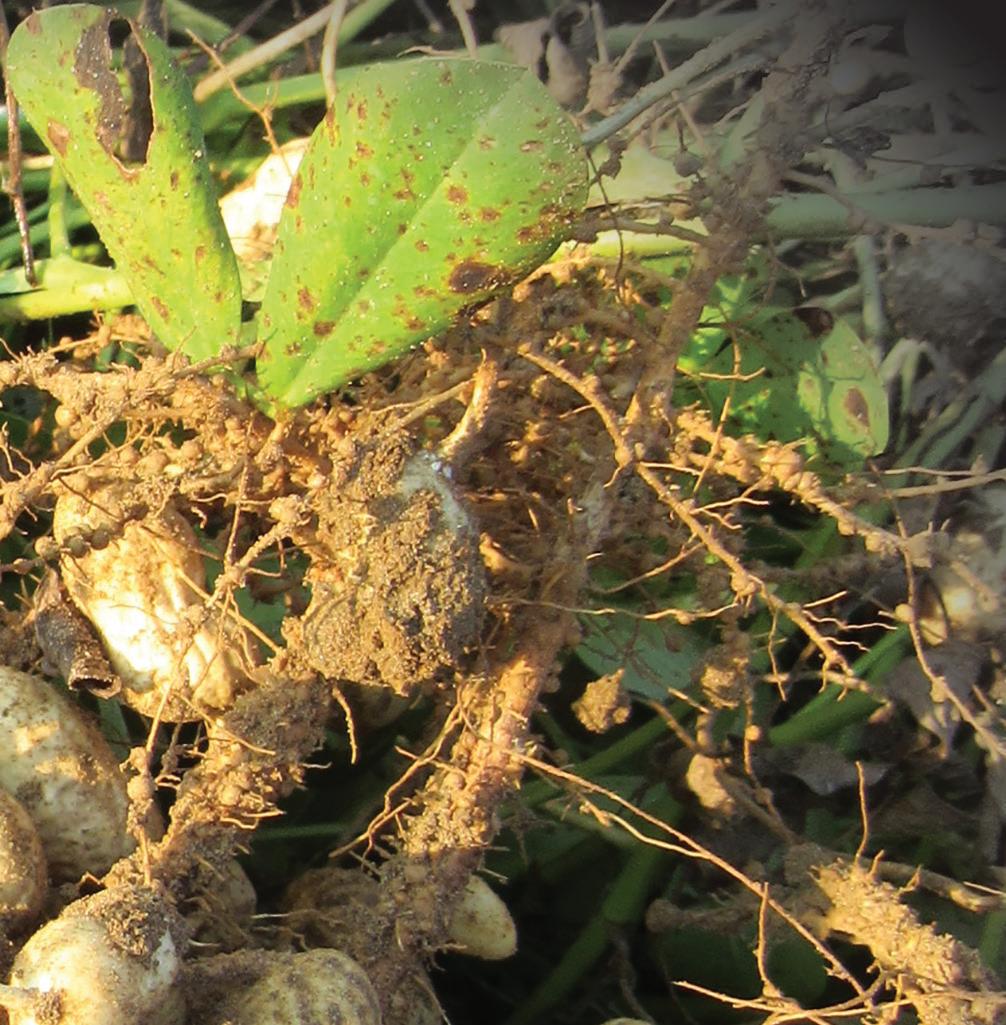

Don’t miss an issue! Scan the QR code with your phone to renew today for FREE!

JUNE 2023 • THE PEANUT GROWER / 15 TWITTER: @PEANUTGROWER To advertise, contact Associate Publisher/Sales Scott Emerson, 386-462-1532 or semerson@onegrower.com
Look Out For LCB
Scouting is the best way to discover this and other yield-robbing pest problems.
By Amanda Huber
Peanuts are popping up in fields, and scouting should begin in earnest to get ahead of any potential pest problems.
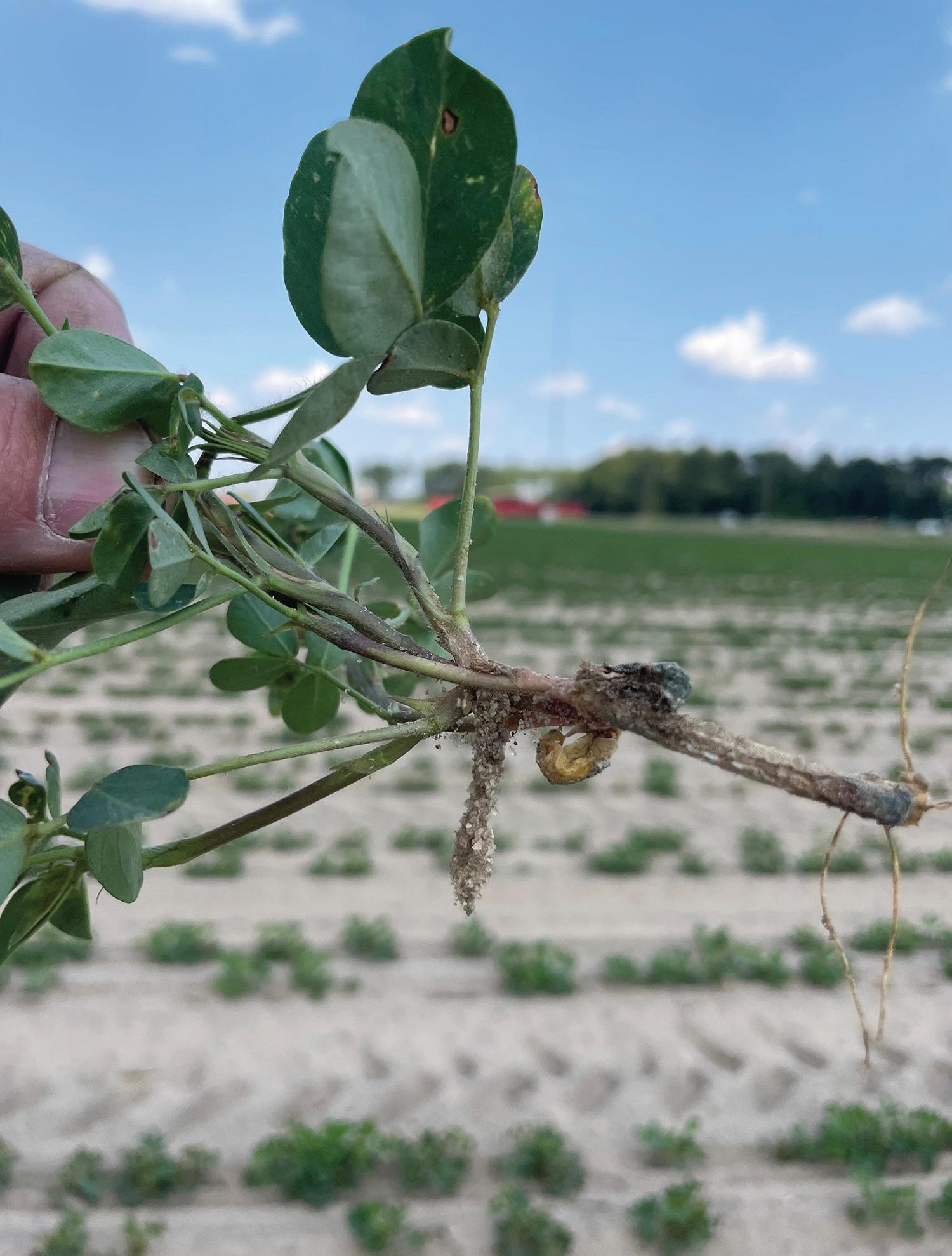
“Last year was a record-breaking lesser cornstalk borer year. So, that should still be top of mind for most everyone,” says FMC technical service manager Blaire Colvin. “You want to scout weekly, and depending on the location and weather, they can show up earlier than you ever realize.”
University of Georgia Extension entomologist Mark Abney says LCB is the most damaging insect pest of peanut in Georgia.
“It feeds on stems, pegs and pods, and it will reduce yield and increase the risk of aflatoxin contamination. Lesser cornstalk borer thrives when it is hot and dry,” he says.
There are two big mistakes to avoid, Abney says, both of which can be prevented with scouting.
“First, not every field will need to be treated with an insecticide. Spraying every field because lessers ‘might’ be present is a bad idea. We do not need to use insecticides to prevent LCB infestations. When the pest reaches threshold, we can treat it, kill it and move on.
“Second, missing an LCB infestation will result in significant losses.”
When To Treat
Scouting for LCB is an important task, Colvin says of this pest that can be hard to find.
“Look in areas where the vines are wilted or any skips in the row for any signs of the pest. You may not see the caterpillar, but instead find the silken tubes they have made.
“The best way to check for insects on peanuts is to vigorously shake or slap the vines. This will knock caterpillars from the vines to the ground. Then, pull
the vines back and see what has been knocked off onto the ground.”
Colvin says there can be a variety of species in peanut from multiple types
16 / THE PEANUT GROWER • JUNE 2023 PEANUTGROWER.COM
Scout for LCB by vigorously shaking plants to knock caterpillars to the ground. However, finding these silken tubes may be the only sign of the pest to be found.
of armyworms, tobacco budworm, corn earworm, redneck peanut worm, velvetbean caterpillar, green cloverworm, soybean looper and lesser cornstalk borer.
“Typically, it will be worth it to spray if you have four to eight caterpillars per row foot. That’s the range that should trigger an application to protect your yield,” Colvin says.
Abney says to use the lower end of the range if vines are small or growing poorly and use the higher threshold value when plants are vigorous and rank.
“Finding caterpillars by the fence row, field path, pivot point, etc., does not necessarily mean a field needs to be treated. If the average number of caterpillars per foot of row from at least 10 random samples is less than the threshold, it will not pay to treat,” he says.
Insecticide Options
Colvin says another rule of thumb is if 30% of the places you check have signs of LCB, you probably want to make an application to prevent yield loss from that pest.
“It can be damaging if you don’t realize you have them. There are really only a couple options for what you can spray in that instance, and Vantacor is an excellent choice that has a long residual and is very effective on LCB,” she says.
Using a product that contains a pyrethroid will put you at increased risk for spider mites,” he says.
When To Move On From LCB
Abney also says rain does not kill LCB and they can’t be irrigated away, either.
“If we experience lower temperatures and regular rainfall, we will see numbers dwindle. Once peanut vines lap the row middles, irrigated fields that are watered adequately will rarely experience LCB
Look For Disease As Well
While scouting for insects, also scout for disease.
“When I think of late season, I think of disease, particularly leaf spot, and keeping your vines intact so you can dig and get them out,” Colvin says. “If you lose more than 50% of your leaves, you might get pod shedding.
“You should have a solid fungicide program going, but depending on the year, if leaf spot starts to blow up, you may want to make an additional spray. However, if you’re all the way at 120 to 125 days and if your vines are in good condition in regard to disease and defoliation, then you probably don’t need to make another application if you’re going to dig at 135 days.
Vantacor’s rate ranges from 1.2 ounces to 2.5 ounces, but Colvin recommends 1.4 ounces per acre. “We’ve gotten good results with that rate for lessers. It’s a lowuse rate. With good coverage, you’ll typically get two to three weeks of residual control. It has minimal impact on beneficials, which is important, and you are not going to flare spider mites.”
Besides Vantacor or chlorantraniliprole, which is a reformulation of Prevathon, Abney says novaluron, or Diamond, is also listed for lepidopteran species in peanut. However, he cautions against using anything else.
“Using a less-expensive product that doesn’t work will not save you any money.
populations above threshold.”
As the name implies, LCB bore into stems, pegs or pods of developing peanuts. However, a different pest can strip a field of all its leaves if not caught in time, thus the reason to scout weekly and correctly identify the insect pests found.
“It is important to know which caterpillars you have when scouting, and one reason is because of the difference in the speed of defoliation of various ones,” Colvin says. “If I see velvetbean caterpillar, we’re going to get the sprayer out very quickly.

“Velvetbean caterpillar tends show up later in the season, which is another reason to continue scouting.”
“A lot of peanuts have been going later, so if it’s more like 140 days, then it’s about the condition of the vines from whatever stresses they’ve had,” she says.
Colvin recommends FMC’s Lucento, which she says is excellent on early and late leaf spot and white mold disease.
“Thinking about the whole peanut season, my main encouragement is to get out there and scout. Get out of the truck, walk into the field and shake some vines around,” she says. “If you have a consultant, great. But there are also great resources in Extension and in the industry. Primarily, you’ve got to know what’s going on in the field. Make the correct identification, know the application threshold and put out the correct pesticide to protect yields. PG
JUNE 2023 • THE PEANUT GROWER / 17 TWITTER: @PEANUTGROWER
Lesser cornstalk borer is the most damaging insect pest of peanut in Georgia, says UGA Extension entomologist Mark Abney. It feeds on stems, pegs and pods, reduces yield and increases the risk of aflatoxin.
“The best way to check for insects on peanuts is to vigorously shake or slap the vines. This will knock caterpillars from the vines to the ground. Then, pull the vines back and see what has been knocked off onto the ground.”
Guiding The Way Forward
USDA’s Southeast Climate Hub developed commodity guides, including peanuts, to help in preparation and recovery from hurricanes.
By Amanda Huber
Much of the peanut belt has another distinction, that of being coastal states open to the threat of hurricanes. Peanut season for most of this area is May to October and coincides with hurricane season, which is June to November.
To help producers remain resilient and productive in the face of this threat, the U.S. Department of Agriculture’s Southeast Climate Hub, along with other USDA agencies and university Extension experts, developed commodity guides to help prepare for and recover from hurricane events. The Southeast commodity guides contain hurricane preparation and recovery guidance and resource links for the most economically important agricultural commodities in the region.

Build Resilience Into Your Farm



The Southeast Climate Hub works to deliver science-based knowledge and practical informa-
tion on climate variability and change to farmers, ranchers and forest land managers. It connects public, academic and private sector organizations with researchers and outreach specialists to deliver technical support and provide tools that help producers cope with challenges associated with drought, heat stress, excessive moisture and changes in pest pressures.
Nancy Gibson, USDA environmental technician with the Southeast Climate Hub, says the purpose of the guide is to build resilience to and recover more quickly from hurricanes.
“There are 23 different common agricultural commodities included in the guides, which have details for coastal states from Louisiana to Virginia. The goal is to help producers remain resilient and productive,” she says.
 Written By Peanut Specialists And Researchers
Written By Peanut Specialists And Researchers

The guides are featured on the main page of
To Find The Guide For The Hurricane Preparation and Recovery in the Southeastern United States “Peanut Producers Guide,” go to www.climatehubs. usda.gov/hubs/ southeast/topic/ hurricane-preparation-and-recovery-southeast-us or www.climatehubs.usda.gov/ hubs/southeast and click on “topics,” then “crops,” then “Hurricane Preparation and Recovery Guides.”
PEANUTGROWER.COM
Build a resilient farm so that when the inevitable hurricane comes, recovery is possible.
the Southeast Climate Hub website. The “Peanut Producers Guide” is written by Barry Tillman, University of Florida agronomy professor and assistant director of the North Florida Research and Education Center in Marianna; Dan Anco, Clemson University Extension peanut specialist and David Jordan, North Carolina State University Extension peanut specialist.
The guide focuses on long- and shortterm planning and preparation to mitigate the impacts of hurricanes on peanut production, potential impacts of wind and water on peanut production and rebuilding and recovery after a hurricane.

This guide, and those of the other agricultural products, is separated into four primary sections: building a resilient operation, long-term operation maintenance, short-term preparedness and, finally, post-hurricane recovery.

A Farm Emergency Plan Template
For producers, the section on building a resilient operation outlines a range of considerations and systems that producers can put in place to increase their resilience to hurricanes. Long-term operation maintenance lists specific pre-hurricane actions and periodic checks to be done on an annual basis (before hurricane season) and monthly basis (during hurricane season). The section on short-term preparedness lists specific actions to be done in the week before a hurricane arrives.
The final section, post-hurricane recovery, outlines activities that producers can take to minimize their losses following a hurricane. It begins with actions immediately following a hurricane
Although nothing can prevent a hurricane from disrupting your operation, having a prepared plan and an emergency contact list will take the guesswork out of what to do when the storm has passed.
that are focused on safety and continues with ongoing actions a week out and a month out.
The guide also includes an appendix with two customizable templates for a

Farm Emergency Plan and an Emergency Contacts List. Both the plan and list should be periodically reviewed, as mentioned in the long-term operation maintenance section. The appendix also includes an initial site planning guide that can be referenced if purchasing or leasing new land, and resource links to helpful federal, state and Extension websites are also referenced throughout the guide.
Hurricane preparedness can have a direct effect on your farm’s profitability and long-term survival. For agricultural operations in hurricane-vulnerable regions, it is critical to have a Farm Emergency Plan in place outlining key tasks and different people’s roles and responsibilities as you brace for the hurricane. PG
Short-term preparedness (1–7 days before a hurricane is forecast to strike)
First and foremost, take whatever precautions necessary to protect your family, your employees and yourself. After that is accomplished, focus on protecting your farm. Once forecasters have put your area in a hurricane’s path, there are a number of precautions you should take to prepare.
Crop


■ Harvesting
If flooding is likely in certain fields, it is probably better to delay digging until after the hurricane has passed, since the peanut
plants can float and be pushed by the wind across flooded fields. While freshly dug plants that are still green are less likely to be blown around by the wind, plants that have dried are more susceptible to be moved by wind and wind-blown rain.
■ Apply fungicides

Consider application of fungicide to slow epidemics that could develop from pathogens and subsequent disease.
■ Pivots
Park pivots in locations that are:
— Accessible to repair in case they topple.
— Away from low-lying areas that could flood.
— Away from areas where trees and other debris could impact systems.
JUNE 2023 • THE PEANUT GROWER / 19 TWITTER: @PEANUTGROWER
The following is an excerpt from the guide in the section on shortterm preparedness.
Peanut Producers Guide
Peanut Pointers

Be Timely With Fungicides


Hopefully, everyone has finished up planting or is almost done by now. I know we didn’t get an early start to planting this year because of the cooler temperatures in April, which has seemed to be the trend the past few years. Still, here’s hoping everyone has a solid stand of peanuts and that the crop is off to a good start.
Now’s the time to scout around for those early season weed escapes and clean them up while they are small and easy to control.
Then, we need to begin our fungicide program. Disease control is one of the most expensive inputs in peanut production. Everyone wants to make the highest yield and save
money by reducing the number of sprays. My advice is to start spraying peanuts for leaf spot when they are around 40 days of age. We don’t want to get behind and spend more money trying to play catch up, then still suffer yield losses in the end.

You must get the fungicides on the plants before the disease gets established with the recommended rate and volume of spray for good canopy coverage. Also, I think banding some of the high-end fungicides early is an excellent way to cut costs and still provide good protection. There may be times to delay sprays later in the season that in the end wind up saving a trip across the field, but the first one is not the one to skip or delay.
One last tip is to pull a pegging-zone sample about 2-3 inches deep in the row to ensure we have adequate calcium levels for pod fill. Gypsum is a great product when you have a high pH but a low calcium level. Also remember, gypsum is important on dryland acres since it is water soluble enough to allow it to enter the soil solution faster than lime when rains are scattered and sparse.
20 / THE PEANUT GROWER • JUNE 2023 PEANUTGROWER.COM
KRIS BALKCOM Auburn University Extension Specialist
Peanut Pointers
Look At Pegging-Zone Soil Test And Ca:K Ratio
A majority of the peanut crop is planted and off to a good start; however, growers did face a few obstacles along the way. Cool, wet conditions caused some stand issues in late April- and early Mayplanted peanut. The good news is that a majority of the crop was planted once temperatures finally warmed up, allowing peanuts a better chance to germinate and emerge. As we move into June, growers need to start transitioning from planting to managing the crop to ensure high-yield potential. Therefore, growers need to form a plan to protect the crop from pests and weeds and to provide peanuts with needed fertility.
The No.1 way to protect the crop from pests is to hire a consultant or scout to provide feedback needed to make effective management decisions. This is especially helpful for insects and weeds. I know growers already have their fungicide programs in mind, but having someone scouting the crop can also help with changes in plans or chemistries if severe outbreaks occur.
When it comes to needed fertility, calcium and boron are two important fertility components to be mindful of in June. Decisions on calcium and boron applications need to be finalized over the next few weeks. Currently, about a third of the crop is moving into the 40-to-60 days after planting range. If your soil test results indicate at least 500 pounds per acre calcium in the top 4 inches of soil (the pegging zone), AND a Ca:K ratio of 3:1 or higher, then you are not likely to see a yield response to calcium fertilization. However, all seed peanuts should automatically receive 1,000 pounds per acre of gypsum, no matter the calcium level in the soil. If you are unsure about a calcium product, put your fertilizer dollars into gypsum rather than an unproven or untested product.

For boron, growers need to apply 0.5 pounds per acre. Boron applications can be achieved in a number of ways. The easiest method is foliar feeding at 0.25 pounds per acre tank-mixed with your first two fungicide sprays. Make product decisions wisely. Beware of products recommended at very low rates. For example, 6 ounces of a 5% liquid boron solution only gives you 0.025 pounds of boron per acre.



If you need help in any way, call your county Extension agent. I hope everyone has a great production year.
Count Active Nodules To Determine Nitrogen Fixation
Four to five weeks after planting is a good time to scout for nodulation. Research has shown that nitrogen fixation of peanuts can occur with a broad range of Bradyrhizobium and other rhizobia strains. Nodulation and nitrogen-fixation activities of peanuts can vary widely depending on the storage of the inoculum, liquid versus powder, soil temperature, status with regard to salinity, fertility and acidity, water availability, crop rotation, fertilization practices, pesticide application, etc.
In addition to the abiotic factors, nodule size also has direct impact on effectiveness and activity of nitrogen fixation. The highest nitrogen-fixation activity is correlated with medium size nodules (0.06-0.08 inch or >1.5-2.0 mm), compared with the smaller (<0.06 inch or 1.5 mm) or larger (>0.08 inch or 2.0 mm) size nodules. When scouting nodulation on your peanuts, it is a good idea to check nodule size as well as the color of internal tissue. Carefully dig plants and count the number of active nodulations. Active

JUNE 2023 • THE PEANUT GROWER / 21 TWITTER: @PEANUTGROWER
SCOTT MONFORT University of Georgia Extension Agronomist
EMI KIMURA Texas A&M AgriLife Extension State Extension Peanut Specialist
Peanut Pointers
and healthy nodules should appear reddish-pink inside due to the reaction of leghemoglobin. Supplemental nitrogen is not required if an average of 20 active nodules per plant is observed. It is not common to apply additional nitrogen in the properly inoculated peanut fields. If supplemental nitrogen is required, 10 to 20 pounds per acre of N should be sufficient, depending on the number of active nodules per plant and residual N in soil and irrigation water.
Prevent Weed Competition And Interference

In the Virginia-Carolina region, I often consider June a transition month, especially as we move to the last week of the month. We have dealt with weeds and thrips as high priorities in May. I hope that our residual herbicides at planting, and likely paraquat and Basagran applied with additional residual herbicides, have been effective. Weed scientists often refer to the “critical period of weed control” as the first three to six weeks of the season. If we can keep the crop clean during that period, we have likely protected it well enough to optimize yield.
Preventing early season weed interference is where we get the most out of our herbicide programs. However, peanuts are unique compared to some of our other crops. Because they never get very tall, it does not take much for a weed to get above the canopy. That fact, along with the need to dig and invert vines and because we make numerous fungicide applications, requires us to keep fields weed-free for the balance of the season. Our window for paraquat often ends in June (spraying within four weeks after peanut emergence) and we’ll need to shift to PPO inhibitors (Storm, Ultra Blazer, Cobra, 2,4-DB, selective grass herbicides, or Cadre/ Impose).
Our insect control needs to also shift from suppressing thrips to addressing rootworms, spider mites and foliar-feeding insects. We have good options for spider mites — if we are timely — and foliar-feeding insects. Pyrethroids are about 60% effective on corn earworms, while the more expensive products are almost completely effective and do not flare mites, in most cases.

We do not have a chemical option for rootworms. There is a void in the absence of chlorpyrifos (Lorsban). In our research, we have not seen value in multiple postemergence sprays of insecticides to control adults. Some of these prod-


ucts are expensive when you consider three sprays. We encourage growers to apply gypsum later in the month, although I suspect by the time this column comes out, a lot of gypsum will have already been applied. My concern on early applications is big rain events we often get in early to mid-June when peanut plants are small. I hate to see soil and gypsum wash down to the middles.
Planning for leaf spot and stem rot sprays is high on the list in June. Further south, many growers begin their fungicide sprays 30 days after planting. In the mid- and upperV-C region, we recommend starting at about 45 days after planting but no later than July 10. Generally, temperatures are higher further south and peanuts have likely come up more quickly after planting, but inoculum for leaf spot can also be higher. This is why we can often get by with a fivespray program in North Carolina and Virginia compared with more sprays in Alabama, Florida, Georgia and South Carolina. We also refer to the R3 stage of growth as the starting point in North Carolina. This would be the case unless peanuts were planted late, and in that instance, we need to initiate sprays no later than July 10.
As we move into July, do not forget to include manganese and boron. In most cases, these products can be applied with herbicides, fungicides and insecticides. Prohexadione calcium (Apogee or Kudos) will come later, well into July. PG
22 / THE PEANUT GROWER • JUNE 2023 PEANUTGROWER.COM
In the absence of chlorpyrifos, there is not a chemical option for rootworms.
DAVID JORDAN
North Carolina State University Extension Agronomist








With

Always read and follow label directions. Provysol is a registered trademark of BASF. © 2023 BASF Corporation. All rights reserved.
powerful defense against leaf spot and suppression of white mold, your peanuts can focus on one thing—living up to their most profitable potential.

























































































 Written By Peanut Specialists And Researchers
Written By Peanut Specialists And Researchers























